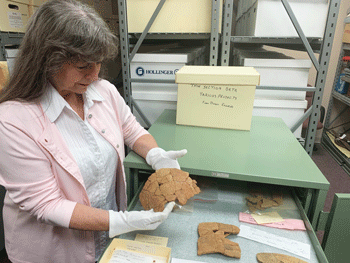 Linda Carnes-McNaughton has spent her career as an archaeologist and works as such on Fort Bragg. “I discovered anthropology, the study of human cultures, biology and behaviors.
Linda Carnes-McNaughton has spent her career as an archaeologist and works as such on Fort Bragg. “I discovered anthropology, the study of human cultures, biology and behaviors.
It seemed like a perfect fit, then I went on ‘a dig’ and knew that was what I wanted to do forever, I wanted to learn about people of the past through discovery.”
As a military brat, Carnes-McNaughton was immersed in other cultures as a child when the family moved around. In Japan, at the age of 6, she took language classes, traditional dance and crafts and enjoyed the games she played with Japanese children.
“I think that experience, that exposure, that immersion into another culture at such a young age, planted the seed of anthropology in my head.”
In her current work, Carnes-McNaughton said archaeologists are able to engage with folks who have direct connections to this land as well as others who want to know more about the people of the past.
She goes on to say, “One of our current responsibilities is working with federally-recognized Indian Nations who once called the Sandhills their homelands. Building respectful long-term relationships with these heritage families enhances our understanding of this landscape and its vital natural resources.”
“The term ‘heritage families’ refers to families whose ancestors we know from documentation and oral histories once lived on this landscape. Their ancestors could have been Native Americans, or early colonists or former enslaved Africans who lived here, raised families here and may have died here, and are buried in one of our 26 early historic cemeteries. The work we do in discovering people of the past is greatly enhanced by the families’ histories shared by descendants. Often, we can share what we learn about an old farm or house site with descendants and they will then share their knowledge with us.”
At this point in her career, she has been on nearly 100 digs, most of those in the southeastern United States, but primarily in North Carolina.
“Once I was fortunate enough to do a small survey in Northern Ireland on historic pottery manufacturing sites. Over the years, I worked as an archaeologist for university-sponsored field projects, private-consulting agencies, and state- and now, federal-government programs,” she said.
“The sites ranged in age from prehistoric times to historic cultural periods; sites like 2000-year old soapstone quarry sites, to 19th century tar kilns, or early pottery kiln sites, to battlefield sites, home sites, colonial towns, prehistoric village sites, some cemeteries and even work on pirate shipwrecks.”
Carnes-McNaughton co-authored the book “Blackbeard’s Sunken Treasure: The 300-year Voyage of Queen Anne’s Revenge,” with Mark U. Wilde-Ramsing. She really enjoyed working on the project. “I specialize in material culture studies (the artifacts – how they are made, what they date to, what they are used for, how they get recycled and who used them).”
She began as a volunteer on the shipwreck project looking at the pottery and glass recovered on this 1718 site. Then, the work expanded into examining items of personal gear such as items of clothing, smoking pipes, ornamentation like beads and buttons, buckles, etc., as well as navigational equipment, and then cooking or galley artifacts and finally into the realm of maritime medicines such as looking at medical equipment found on the wreck.
“All this research led to a better understanding of who is represented by the artifacts, leaning more about activities that took place and how the remains of the wreck ended up on the ocean floor,” Carnes-McNaughton said. “My co-author was the former QAR project director, an underwater and we realized that between us we made a great team to document what has been found on this important shipwreck. I enjoy this research as much as I enjoy pottery research.”
Working outdoors has always appealed to Carnes-McNaughton and excavation has always been her preferred avenue of discovery. She enjoys the fieldwork the most but also enjoys interaction with the people (descendants and others) who have a vested interest in the history of the Sandhills and pre-Fort Bragg landscape. She also likes starting a conversation by sharing a single artifact and talking about what it means to different people. That is oftentimes very intriguing.
“If I had to pick one single site that was a life-changing experience it was helping to excavate the oldest European-style pottery kiln found in North America, the 1566 kiln at the Spanish fort site of Santa Elena on Parris Island, South Carolina.” said Carnes-McNaughton. “That was sheer delight.”
Carnes-McNaughton encourages others to explore the field in which she has found a rewarding career.
“Archaeology is important science in that it helps us look at the past in order to understand the present and future of our place on this planet. Being an archaeologist means looking at the world around us in a different perspective. We learn to be humanists at the same time we practice our science.”
Pictured above: Linda Carnes-McNaughton is an archaeologist on Fort Bragg. (Photos courtesy Fort Bragg Garrison PAO)